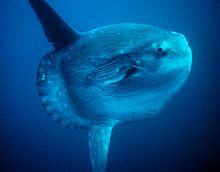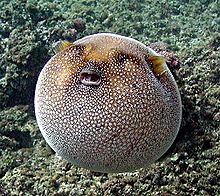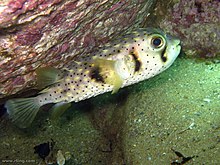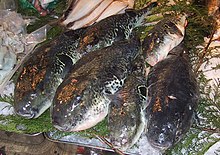Puffer fish-like
| Puffer fish-like | ||||||||||||
|---|---|---|---|---|---|---|---|---|---|---|---|---|

White-spotted filefish ( Cantherhines macrocerus ) |
||||||||||||
| Systematics | ||||||||||||
|
||||||||||||
| Scientific name | ||||||||||||
| Tetraodontiformes | ||||||||||||
| Berg , 1937 |

The ball Fishy (Tetraodontiformes) ( ancient Greek τετρα- tetra "four", ὀδόντες odóntes "teeth", Latin forma "shape"), also Tetraodontiformes , puffer Similar or now obsolete prison pine (Plectognathi), are an order of bony fishes , with over 430 known Species. They include the triggerfish (Balistidae), the filefish (Monacanthidae), the boxfish (Ostraciidae), the pufferfish (Tetraodontidae), the porcupine fish (Diodontidae), the sunfish (Molidae) and four other, less well-known families. In terms of their morphological characteristics and their way of life, they are one of the most diverse bony fish orders and inhabit a wide variety of habitats . More than half of all species are reef-related , but there are also inhabitants of seagrass beds and other tropical coastal ecosystems, as well as pelagic forms (sunfish) and inhabitants of the deep sea among the puffer fish relatives .
The German name Haftkiefer refers to the fused intermaxillary bones (premaxillaries) and jaw bones (maxillaries) as well as some other modifications of the skull that are common to all species and only occur in this order.
features
External anatomy
Almost all puffer fish-like have a stocky, high, diamond-shaped, rounded or angular and stiff body. The smallest representatives with a length of two centimeters are the filefish Rudarius minutus and the dwarf pufferfish ( Carinotetraodon travancoricus ). With a length of 3.30 meters, a height of 4 meters and a maximum weight of 2.3 tons, the sunfish ( Mola mola ) is not only the largest puffer fish relative, but also the heaviest bony fish of all.
The dorsal and anal fin are symmetrically opposite each other, far back in front of the caudal fin . They form the main driving organ in most puffer fish species and provide propulsion when swimming ("balistiform") through wave-like movements, and in sunfish through paddle-like movements. The caudal fin is only used to change direction. In the sunfish it is only present in the larval stage and when the metamorphosis is complete it is replaced by a fin edge on the blunt-ended body. The pelvic fins and then the pelvic bones are missing in the puffer fish , the porcupine fish , the box fish and the sunfish. In the hornfish , three- spined fish , triggerfish and filefish , they are transformed into a fin spine . Together with the trigger mechanism from the first three hard rays of the dorsal fin, they serve the members of the last two families to wedge themselves into hiding places. The anal fin generally has no spine rays. The porcupine fish swim mainly by undulating their broad pectoral fins.
The always relatively small, round or slit-shaped gill openings are located directly at the base of the pectoral fin. The narrowing of the gill opening results from an adhesion of the gill membrane to the skin of the trunk - another feature that all puffer fish share. The mouth is small and covered with a few small, hard teeth, which are mostly fused into tooth plates, which means that the jaws take on a parrot's bill-like character (with only two, three or four strong tooth plates in the tetraodontoid). The body is scaled (trigger fish), without scales (puffer fish), or the scales are transformed into large plates (box fish) or erect spines (porcupine fish and many puffer fish). Many species, especially those living in coral reefs , have very brightly colored, striking drawing and coloring.
Internal anatomy
Their number of vertebrae is at most 30, but mostly below 20, the lowest of all fish; the boxfish of the genus Ostracion have only 14 vertebrae. As already shown, some of the groups lack the pelvic bones, which were reduced together with the pelvic fins. Many species also lack ribs. All puffer fish relatives with the exception of the sunfish have a swim bladder . The skeleton of the pelagic sunfish is therefore only slightly ossified in order to save weight.
Further apomorphies of the skull in addition to the fused jawbones are the absence of the parietal bones (parietals), the nasal bone (nasals), as well as three other skull bones: ( extrascapulars , intercalars and infraorbital ); the lateral line organ is also no longer present on the head.
distribution
Most of the over 400 species inhabit the coasts of tropical seas on coral reefs, some species also penetrate into temperate latitudes. The sunfish, the three-spined fish and some trigger and puffer fish, on the other hand, live pelagic in the open ocean. In the Mediterranean there is one type of triggerfish, one filefish, one porcupine fish, two sunfish, four types of boxfish and seven puffer fish. The porcupine fish, the filefish and the two puffer fish species have only migrated through the Suez Canal into the Mediterranean in the last few decades ( Lesseps migration ) and only live in the eastern Mediterranean, on the coasts of Israel , Lebanon and southern Turkey . On the German coasts, in the North Sea and the Baltic Sea, there are no puffer fish species that live permanently. Only the sunfish ( Mola mola ) sometimes reach the western Baltic Sea on their migrations.
Among the puffer fish there are species that live in the estuaries in brackish water ; in tropical South America , Africa , India and Southeast Asia there are also 14 pure freshwater forms .
Way of life
Social behavior
Puffer fish are mostly solitary and often very aggressive towards other species. Some triggerfish and filefish live in pairs. Pointed puffer fish often form schools of up to a hundred animals at times.
Puffer fish can produce sounds by grinding their teeth or by vibrating their swim bladder with the help of special muscles.
nutrition

Puffer fish species feed on a wide variety of invertebrates . Puffer fish, boxfish and triggerfish mostly eat hard-shelled bottom-dwelling animals such as crabs , sea urchins , snails and mussels . Some triggerfish primarily hunt zooplankton . Species such as the Palettenstachler , which feed exclusively on the polyps of the stony coral genus Acropora , are food specialists . Pointed puffer fish also eat a lot of plant-based foods. The sunfish that live in the open ocean feed on gelatinous larger planktonic organisms such as jellyfish and salps .
defense

For defense, but also to impress and threaten, puffer fish and porcupine fish enlarge their bodies by absorbing water into a sac in their stomach. You can puff yourself up like a ball. With the porcupine fish, the sharp spines are fixed upright. The triggerfish, filefish, three-spined fish and pointed puffer fish enlarge their bodies by expanding a flap of skin on their belly.
Puffer fish, porcupine fish, sunfish and box fish store the nerve toxin tetrodotoxin in their skin and internal organs, especially in the liver and gonads , which makes them inedible for predators. Boxfish are additionally protected by pahutoxin , which they can actively expel in case of danger.
Reproduction and development
Most puffer fish species are free-spawners who simply eject their eggs and sperm into open water when they mate or, in freshwater creatures, between aquatic plants. Some puffer fish like damselfish spawn on previously cleaned stones ( substrate spawners ). Many triggerfish species dig large pits in the ground where they spawn. After hatching, the young are guarded by their parents for a while until the yolk sac is used up.
External system
The puffer fish-like belong within the real bony fish (Teleostei) to the barbed fishes ( Acanthopterygii) and there to the large group of perch relatives (Percomorphaceae). The monophyly of the taxon is undisputed due to the complex feature of the fused jaw bones and the other characteristic features ( apomorphies ) .
Within the Percomorphaceae, the armfin fish (Lophiiformes) and the boarfish (Caproidae) are probably the closest relatives of the puffer fish-like. The only disputed question is which of the two is the immediate sister group , or whether a taxon formed by the two is the sister group of the puffer fish-like.
The earlier assumed close relationship with the surgeonfish-like (Acanthuriformes), which was based on the similarity of the larvae and the triggerfish with them, is due to convergence .
Internal system
The puffer fish-like are divided into ten recent families, which can be assigned to six suborders.
The probable relationships within the puffer fish species are shown in the following cladogram :
| Puffer fish-like |
|
||||||||||||||||||||||||||||||||||||||||||||||||||||||||||||||||||||||||||||||||||||||||||||||||||||||||||||
|
|
Fossil record
The oldest known ball Fishy is Plectocretacicus clarae from the Upper Cretaceous of Lebanon , he already resembles today's boxfish. Oligobalistes robustus , a triggerfish, originates from the lower Oligocene of the North Caucasus . The most important site is the northern Italian Monte Bolca Formation, which arose from Tethys deposits in the Eocene . It made it possible to describe numerous species of fossil puffer fish-like species, including Spinacanthus imperialis from the trunk line of the triggerfish-like (Balistoidea), the three- spined Protacanthodes ombonii , Eolactoria sorbinii and Proaracana dubia ( Aracanidae ), Eoplectus bloti and Zignoichthysea from the stem line Tetraodontischysoid Puffer fish Tetraodon pygmaeus and the porcupine fish Diodon tenuispinus . The genera Aluteres and Monacanthus , to which filefish still live today, have been passed down from the Pliocene of Fiume Marecchia in northeast Italy.
Puffer fish and man
fishing
Most puffer fish species are not fished because of their toxicity. Only a few larger species of triggerfish and the larger pufferfish known as fugu are caught. Fugu is served as a delicacy in Japanese restaurants that require a special license . Triggerfish are always at risk of ciguatera poisoning, as they are the end links in the food chain ingesting toxins with their food. Hedgehog fish are caught and inflated and sold to tourists.
Aquarium keeping

The smaller types of puffer fish that live in fresh and brackish water are now and then sold as ornamental fish in specialist aquarium stores. They are kept in aquariums structured with woods and stones , but are sometimes considered to be aggressive towards conspecifics and other fish, which is why keeping in a species aquarium is recommended. Puffer fish are also seen as a prophylaxis against snail plagues. Some species have been successfully bred , but most of the fish offered come from wild catches .
In saltwater aquariums , ball fish, trigger fish, box fish and filefish are usually only kept in pure fish aquariums, as they often eat a large number of invertebrates. In specialist shops, tiny boxfish, puffer fish and porcupine fish, only 2 to 4 centimeters in size, are often offered, which people perceive as cute and which are intended to entice them to buy. The potential buyer should know, however, that the animals become at least 30 centimeters long, eat crustaceans , molluscs and echinoderms and, after a while , can also destroy hard and soft corals with their parrot-like beak . Boxfish can release their skin toxins in the event of stress or in the event of their death and kill all remaining fish. Pointed puffer fish and some small filefish species can be kept in the coral reef aquarium. Attacks on corals only occur when the animals are insufficiently or incorrectly fed. All puffer fish relatives offered for the saltwater aquarium are wild-caught.
Large and colorful ballfish and triggerfish are impressive inhabitants of large, public show aquariums. In some huge aquariums in Japan ( Kaiyūkan aquarium in Osaka ) and the USA ( Monterey Bay Aquarium ), visitors are now also presented with sunfish .
literature
Most of the information in this article has been taken from the sources listed here:
- Joseph S. Nelson : Fishes of the World , John Wiley & Sons, 2006, ISBN 0-471-25031-7
- Kurt Fiedler: Textbook of Special Zoology, Volume II, Part 2: Fish , Gustav Fischer Verlag, Jena 1991, ISBN 3-334-00339-6
- Rudie H. Kuiter / Helmut Debelius : Atlas der Meeresfische , Kosmos-Verlag, 2006, ISBN 3-440-09562-2
- Hans A. Baensch / Robert Patzner: Mergus Sea Water Atlas Volume 6 Non-Perciformes (Non-Perciformes) , Mergus-Verlag, Melle 1999, ISBN 3-88244-116-X
- Author collective: Urania animal kingdom, fish, amphibians, Kriechtiere , Urania-Verlag, 1991, ISBN 3-332-00491-3
- Keiichi Matsuura: Taxonomy and systematics of tetraodontiform fishes: a review focusing primarily on progress in the period from 1980 to 2014. Ichthyological Research, January 2015, Volume 62, Issue 1, DOI: 10.1007 / s10228-014-0444-5
Web links
- Puffer fish species on Fishbase.org (English)
Individual evidence
- ↑ a b Francesco Santinia, Laurie Sorenson, Michael E. Alfaro: A new phylogeny of fishes tetraodontiform (Tetraodontiformes, acanthomorpha) based on 22 loci. Molecular Phylogenetics and Evolution, doi: 10.1016 / j.ympev.2013.05.014 , ISSN 1095-9513
- ↑ Masaki Miya et al. (2003): Major patterns of higher teleostean phylogenies: a new perspective based on 100 complete mitochondrial DNA sequences. Molecular Phylogenetics and Evolution, Volume 26, Issue 1, January 2003, Pages 121-138 doi : 10.1016 / S1055-7903 (02) 00332-9
- ↑ Masaki Miya et al. (2005): The phylogenetic position of toadfishes (order Batrachoidiformes) in the higher ray-finned fish as inferred from partitioned Bayesian analysis of 102 whole mitochondrial genome sequences. Biological Journal of the Linnean Society, Volume 85 Issue 3, 2005, Pages 289 - 306 doi : 10.1111 / j.1095-8312.2005.00483.x
- ↑ Betancur-R, R., E. Wiley, N. Bailly, M. Miya, G. Lecointre, and G. Ortí. 2014. Phylogenetic Classification of Bony Fishes --Version 3 ( archive link ( memento of the original from August 14, 2015 in the Internet Archive ) Info: The archive link has been inserted automatically and has not yet been checked. Please check the original and archive link according to the instructions and then remove it Note. ).
- ↑ Yusuke Yamanoue et al .: Phylogenetic position of tetraodontiform fishes within the higher teleosts: Bayesian inferences based on 44 whole mitochondrial genome sequences. Molecular Phylogenetics and Evolution, Volume 45, Issue 1, October 2007, Pages 89-101 doi : 10.1016 / j.ympev.2007.03.008
- ↑ Dahiana Arcila, R. Alexander Pyrona, James C. Tyler, Guillermo Ortí, Ricardo Betancur-R .: An evaluation of fossil tip-dating versus node-age calibrations in tetraodontiform fishes. Molecular Phylogenetics and Evolution. October 2014, DOI: 10.1016 / j.ympev.2014.10.011
- ^ Karl Albert Frickhinger: Fossil Atlas Fish , Mergus-Verlag, Melle, 1999, ISBN 3-88244-018-X
artikelDo not use parameters with different content in the article namespace!




